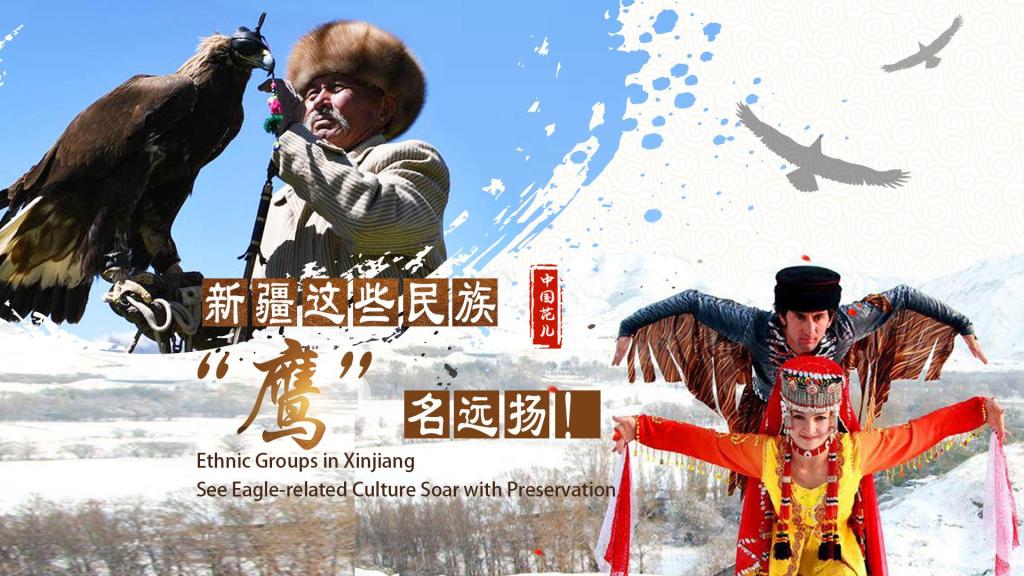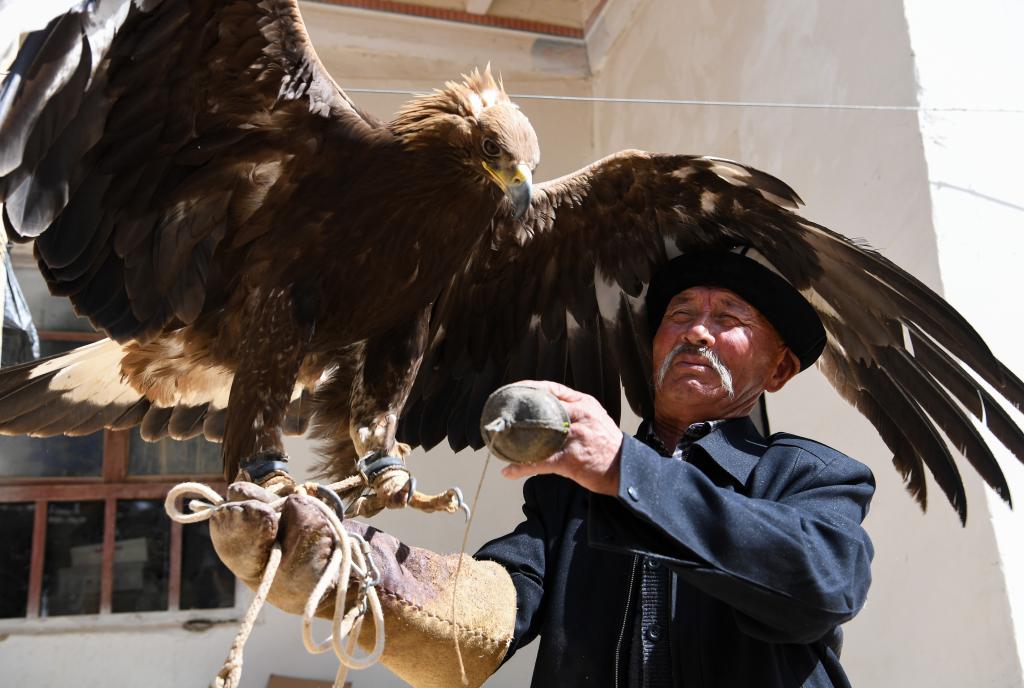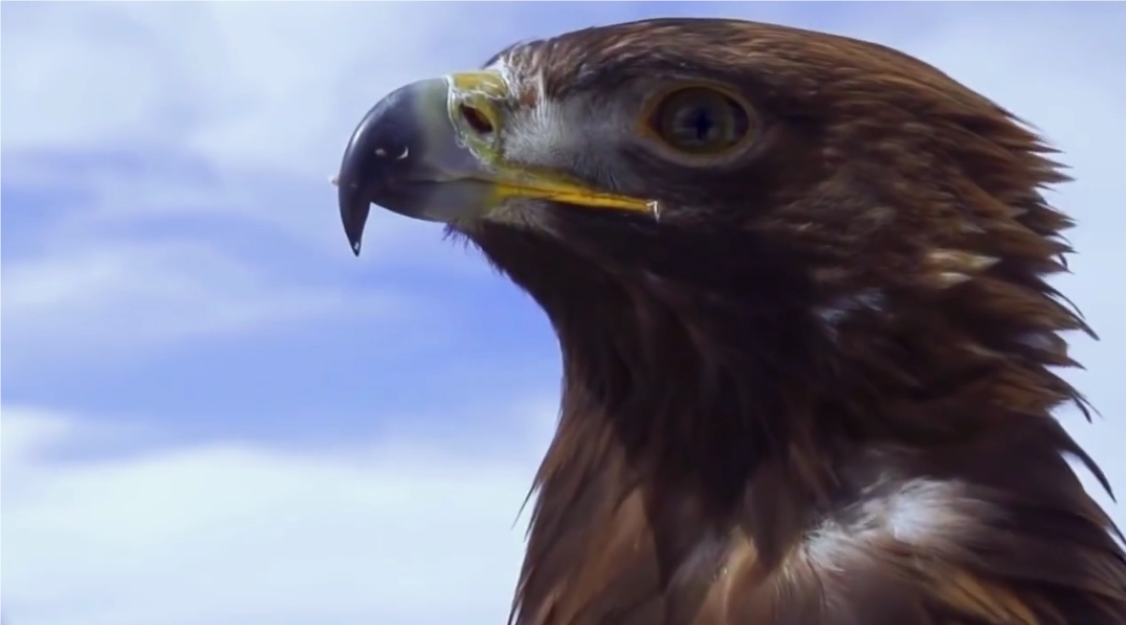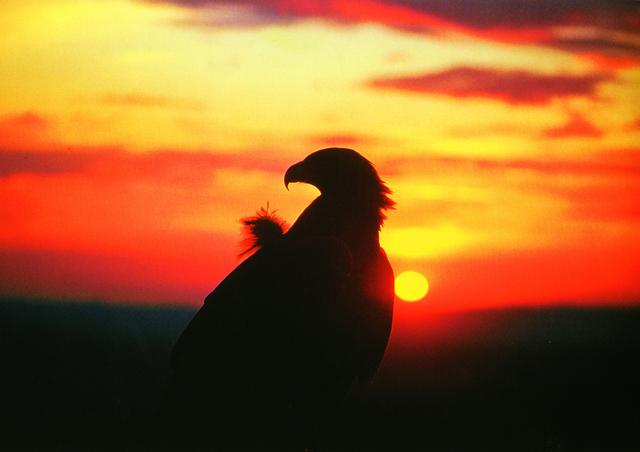这里是“鹰之圣地”,这里是中国新疆。在这里,不同民族形成了各具特色的“鹰文化”。
This is a sanctuary for eagles. This is northwest China's Xinjiang Uygur Autonomous Region. Here, several ethnic groups have developed their distinctive eagle-related culture.

在塔吉克族人眼里,鹰是英雄的象征。
In the eyes of the Tajik people, the eagle is a symbol of heroism.
世代居住于帕米尔高原上的塔吉克族人,对高原雄鹰有一种特殊的感情。能歌善舞的塔吉克族人模仿雄鹰自由翱翔的各种姿态,用“鹰舞”体现对鹰的崇敬。
The Tajik people, living on the Pamir Plateau for generations, have a special affection for the highland eagle. Known for their singing and dancing talent, they imitate the various postures of the soaring eagle in their "eagle dance," expressing reverence for the majestic bird.

柯尔克孜族、哈萨克族,猎鹰是他们一生的朋友。
For the Kirgiz and Kazakh ethnic groups, the falcon is a lifelong companion.
位于天山南脉的阿合奇县,被称为“猎鹰之乡”,是柯尔克孜族的聚居地。柯尔克孜族人世代与鹰为伴,放牧为生。他们驯养雄鹰,以骑马架鹰的方式进行狩猎,这里的猎鹰种类多达60多种。每到“猎鹰节”,牧民会带着他们心爱的猎鹰展示和比赛。
Located in the southern part of the Tianshan Mountains, Aheqi County is known as the "hometown of falcon" and is a settlement for the Kirgiz people.The Kirgiz people, relying on livestock herding for living, have kept eagles as companion for generations. They train and hunt with eagles, using a unique method known as horseback falconry. There are over 60 different species of falcons in this region. During the falcon cultural festival, local herders would showcase and compete with their beloved falcon.

同样拥有“猎鹰”习俗的哈萨克族更侧重于使用体型更大的金雕进行狩猎。哈萨克族居住在新疆北部、美丽的阿勒泰大草原上,手托凶猛金雕,放马奔驰于草原山林中。金雕飞到空中帮马背上的主人寻找猎物,并以时速300公里俯冲捕猎。
The Kazakh people, who also share the falconry tradition, prefer using the larger golden eagle for hunting. The Kazakh people reside in the beautiful Altai grasslands in northern Xinjiang. With a fierce golden eagle perched on their arm, they gallop on horseback across the grasslands and forests. The golden eagle soars into the sky, assisting its owner on horseback in searching for prey and diving at speeds of up to 300 kilometers per hour for the hunt.

这两个民族的驯鹰过程大致是相同的,经过捕鹰、熬鹰、驯鹰、放鹰等几个阶段,一只野鹰就成了猎鹰。
The process of falconry is generally the same for both ethnic groups. After several stages including capturing, taming, training and releasing, a wild eagle will be transformed into a hunting companion.

如今,随着中国保护野生动物政策的完善、牧区经济的发展和生活方式的转变,草原上的驯鹰已基本不再用于狩猎。但鹰依然是人类亲密的伙伴,也是驯鹰人难以割舍的情怀。年轻人接过了父辈手中的鹰,同时被传承下来的,还有人与鹰的“约定”——猎鹰被驯养几年后,将放归自然,繁衍生息。
However, with the improvement of wildlife conservation policies in China, the development of pastoral economies, and changes in lifestyles, trained eagles on the grasslands are no longer used for hunting. Nevertheless, eagles remain intimate companions to humans and hold a deep emotional significance for falconers. Younger generations have taken over the eagles from their ancestors, and along with the tradition, they also inherit the "agreement" between humans and eagles - after a few years of training, the falcons are released back into the wild to reproduce and thrive.
无论是“鹰舞”还是“驯鹰习俗”,作为国家非物质文化遗产,都以自己的方式表达着对自然的热爱,传承着古老的民族技艺。
Both the "eagle dance" and the "falconry tradition are national intangible cultural heritage. Related ethnic groups express their love for nature and preserve ancient ethnic skills in their own unique ways.
来源:中国网 中国范儿